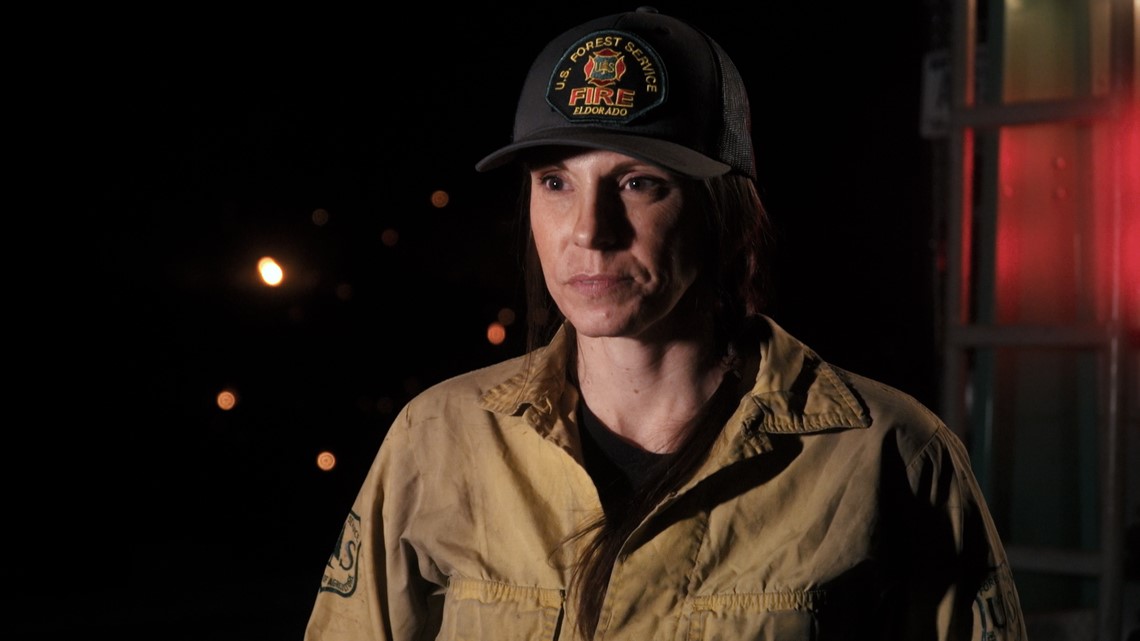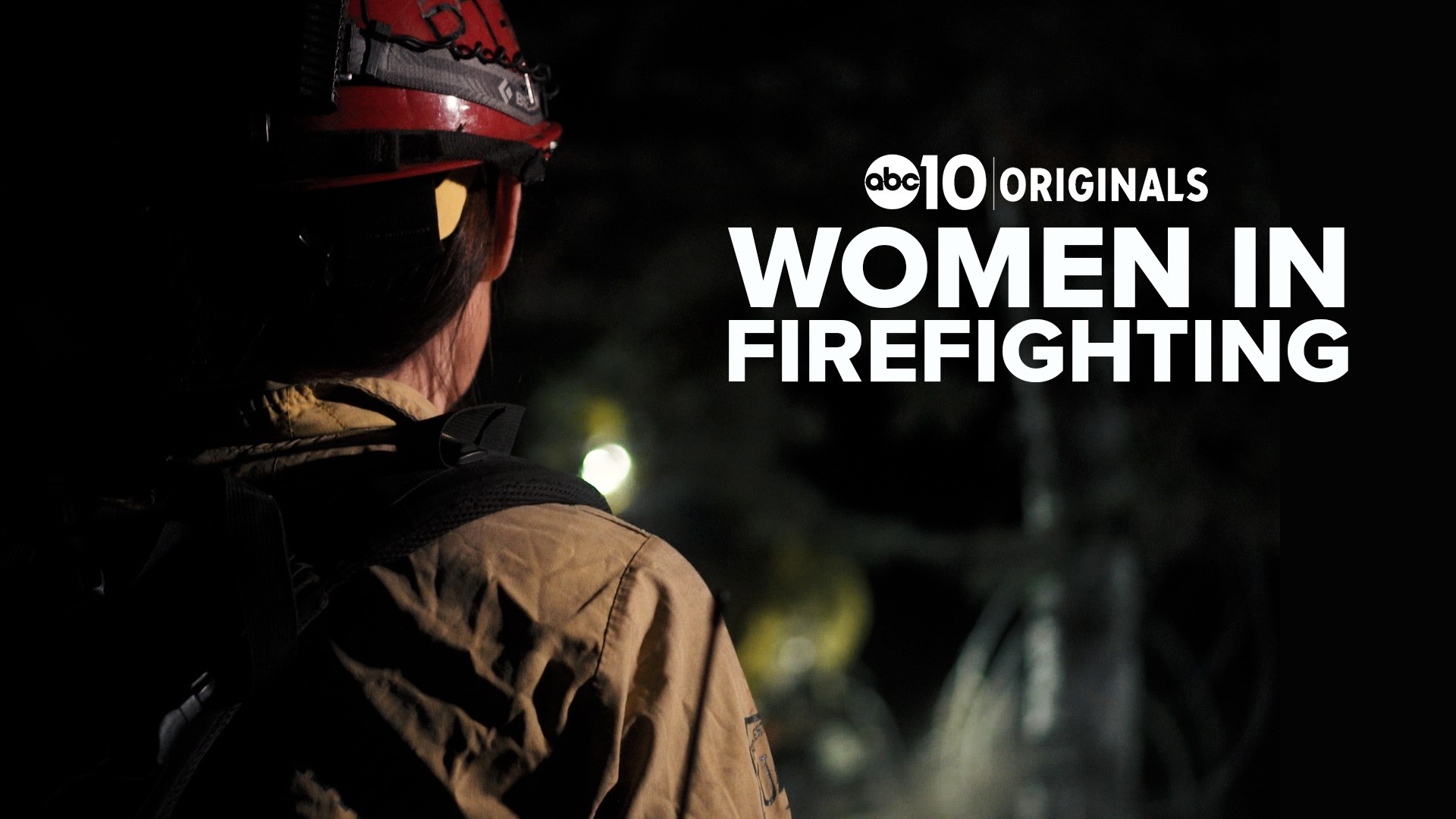EL DORADO COUNTY, Calif. — "I remember when I first got into this job, one of the first people I was working for said, 'You might not want to do the whole nail polish and makeup thing every day. People won't take you seriously,'" Kaleena Lynde recalled. "Since that day I've pretty much always done nail polish and makeup... mainly for the reason I know I will be taken seriously because my training, my experience, my work, how I treat people, what I do will speak to me as a firefighter."
It's Thursday, Sept. 9 around 11 p.m., just the start of Lynde's shift. She expects it'll be a long night as they're prepped for incoming lightning storms, a concerning factor as it's approaching a month now that her and thousands of other firefighters have relentlessly worked to try and contain the Caldor Fire.
Even as as she stands aside her United States Forest Service engine, parked deep in the Eldorado National Forest, fire spots blaze behind her.
The soft crackling of the forest ablaze accompanies her, like a music track, as she recalls a career that started when she was just 19 years old. Her all-male crew watches her ABC10 interview from afar, learning themselves about the life of their engine boss trainee -- a role tasked with overseeing the crew.


About nine miles away, another firefighter is on duty. She's at a different agency, but like Lynde, she got into the fire service at just 19.
"Everyone has something to contribute. That's what makes a really successful agency," said Kim George. "For me, I know I'm never going to be as strong as the guys, but it's not because a lack of trying."
George is one of two female firefighters of 30-plus at the South Lake Tahoe Fire Department station.
The statistic isn't rare. In fact, it's the norm for the nation as women make up less than 10% of the United States' Fire Service, according to the National Fire Protection Association.


As wildfires continue to grow bigger and more destructive each year, ABC10 wanted to get to know the women on the frontlines fighting California's fires, hearing their stories, challenges and finding out why we don't see more women fighting the flames.
So, ABC10 shadowed two leading women during the Caldor Fire. A fire that blazed for over two months, spanned across three counties, burned 221,835 acres, destroyed dozens of homes and came within a hair of South Lake Tahoe.
"We knew the fire [was] approaching Meyers. We were ready to go. We were wanting to do whatever we could to protect our community," George said.
Coincidentally, the day was her 20-year anniversary with the South Lake Tahoe Fire Department.
"There were embers raining, and it was almost to the point of where we were needing to back out," George said.
But they didn't back out. They stood strong, fighting the fire and defending South Lake Tahoe. While they're fully trained for wildfires, George said most of their day-to-day routine is made up of medical calls.
For George and her crew, protecting Tahoe was a welcome and victorious battle. As a municipal fire department, it was a fight to keep her city standing.
For other firefighters, like Lynde, these types of firefights take place deep in the woods. It's the kind of work that goes with her agency, the U.S. Forest Service.
"We have a lot of people that come into this work, and they've spent their lives in the gym. They're very strong in that aspect, but it's a different kind of strength. You're carrying heavy objects up steep terrain for long periods. It's hot. There's ash everywhere. You're getting very dirty," said Lynde. "So, it's not necessarily you're a female and you might not be able to have the upper body strength or because you're male you're going to have it. It's just being able to overcome the challenges mentally to get there together."
Both George and Lynde fought the Caldor Fire while being in leadership roles and overseeing crews.
"It's challenging. It can be," said George. "It's really just at times making sure you're the hardest worker in the room and going above and beyond in different ways."
The limited amount of female firefighters in leadership roles is something some are working to change.
"I actually was the first female that was hired full-time with the department that I work for," said Amy Hanifan. "Early in my career, I didn't necessarily see myself promoting into leadership roles because I had not seen any other females in those leadership-type roles, truly, until I got involved in the Women in Fire Organization."
Hanifan is now the president of Women in Fire, a national non-profit agency. The organization stands as a voice for women in the fire service.
When ABC10 asked why Hanifan believes the fire service is skewed so heavily with male employees, she said one word, "tradition."
"It's a service very founded in tradition... and traditionally, it's been a male-occupied field," said Hanifan. "That changed basically in the 80s."
Hanifan said a cultural shift in the mid-80s and 90s addressed different issues women saw in the fire industry and helped create change.
"I think a lot of women, especially those that were early in that time, had to, for a lack of better term, 'prove themselves' a bit and show they could do the work," said Hanifan.
According to the National Fire Protection Association, since the 80s the number of female firefighters has gone from about 1% to 6% nationwide.
While there is more women, they still make up a miniscule amount of the overall fire force. Specifically, the study conducted by the NFPA said for 370,000 career firefighters only 15,200 were women, or just 4%.
Current information on how many of these women are specifically in leadership roles is difficult to find.
"I would like to see more women encouraged to promote or encouraged to better themselves to be able to get into those positions," said Hanifan. "I would also like to see some numbers on what that looks like."
George and Lynde both have climbed the ranks in their agencies after starting when they were 19.
"They had hired six people," said George. "I was the only female."
"I never really thought of it being boy's work that I was going into. It was just the job I wanted to do," said Lynde. "It never really entered my mind as being something that I couldn't overcome or to be a challenge really."
Within Lynde's first couple of years on the job, she faced a different kind of challenge.
"At the end of my time being on a hotshot crew, we were towards the end of the fire season, I got stage three ovarian cancer," said Lynde.
She was just 22 and had recently started dating the man who is now her husband and who is also a firefighter.
"Five months into dating is when I got cancer, and I gave him the understanding of, 'We both didn't think this was going to happen, and I don't know what the outcome is going to be because it's such an aggressive cancer... So, if you need to need to bail, I totally understand. It wasn't something that you were planning on dealing with at 25-years-old.' I was 22," said Lynde. "He said, 'Nope. Together, I think we're going to beat this.' So, he stuck around, and I knew then it was going to be forever."


It took three years of chemo, radiation and surgeries but Lynde beat the cancer. And while her battle with cancer was at the start of her career and is far behind her as she's been in remission for 12 years now, it's a sentiment to the importance of being aware of your health.
Annual physicals are typically required of all firefighters to ensure they remain healthy as the job comes with stress, physical strain and lots of smoke inhalation. But specific data on female firefighters' health is basically non-existent.
It's something the Women in Fire Organization wants to change as well as bring in new studies.
"I would love to be able to see some of those pieces addressed and really researched to the degree that men's specific cancers are," said Hanifan. "We're (also) currently working on a project where we're coming up with best practice recommendations for OBGYNs who are working with female firefighters through their pregnancies, which is something we haven't had before."
But physical sacrifices aren't the only ones being made by all in the fire service. Warmer temperatures, dry conditions and PG&E caused fires have made fire season an almost year-long fight.
"It is what we signed up for and it's an understanding we have knowing the kind of job we do," said Lynde of her and her husband's work. "Combined in the last year if you take the amount of days I was gone and the amount of days he was gone, it totaled to 236 days apart."


"There's pros and cons; there's things you lose that you sacrifice for it. I have two boys, they're teenagers now but when they were little, it was it was really difficult to leave them at home," said George. "Even just going back home, you'd feel like they'd grown and I'd miss something."
But through their work, women firefighters are displaying a powerful message for the future generations -- one that they hope will be filled with more women on the frontlines of California's wildfires.
"I love that [my son] has this concept that women can do what they want. There's no limitations," said George.
WATCH ALSO:



















